Precis
A major, multi-year investigation at the New York District Attorney’s Antiquities Trafficking Unit has ended in chaos. At least eight of nine ‘ancient’ mosaics returned with great fanfare to Lebanon (with more on their way to Syria) were called ‘treasures,’ irreplaceable examples of the countries’ heritage worth millions of dollars – but they were fakes, modern copies of well-known, authentic mosaics.
A Criminal Prosecution for Antiquities that Weren’t Ancient at All
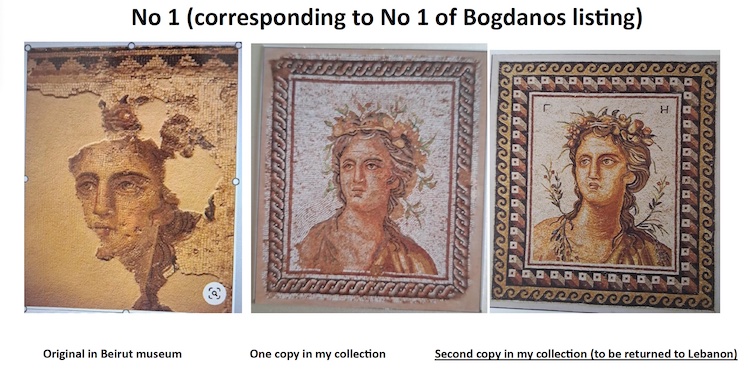
According to a warrant issued in August 2022 for his arrest, Georges Lotfi is the primary suspect in a joint investigation of Middle Eastern antiquities smuggling by the New York District Attorney’s Antiquities Trafficking Unit (ATU) and Homeland Security Investigations (HSI). Lotfi is an eighty-three-year-old retired Lebanese pharmacist who was one of New York Assistant District Attorney Matthew Bogdanos’ informants, having supplied information on looted antiquities to him for some ten years.
The arrest warrant charged Lotfi with Possession of Stolen Property valued over $1,000,000 and twenty-three other felonies. The warrant’s accompanying affidavit was written by HSI Special Investigator Robert Mancene, Matthew Bogdanos’ Homeland Security partner in numerous investigations. The affidavit alleged that Lotfi illegally exported twenty-three valuable ancient mosaics from Syria and Lebanon together with a large Palmyran sculpture and schemed to sell, gift and loan these and other antiquities to U.S. museums and collectors for his own profit. It accused Lotfi of trying to curry favor with Bogdanos and Mancene in order to persuade them to overlook the illicit history of Lotfi’s looted antiquities.
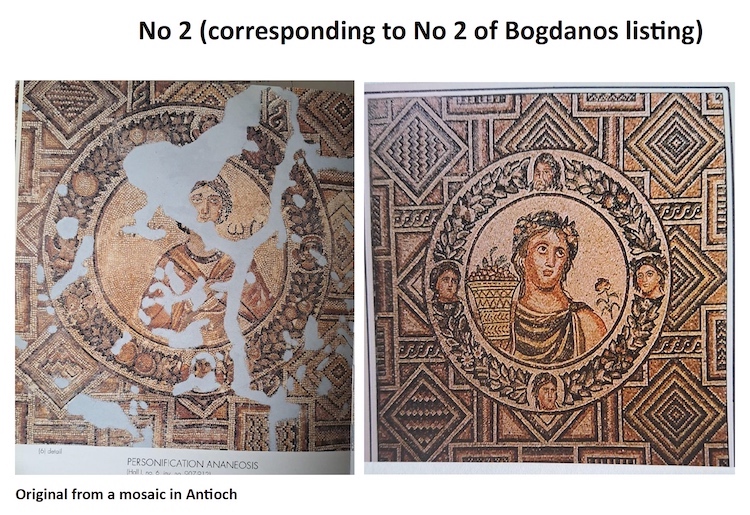
Lotfi now says that he believed that the mosaics were authentic at the time he acquired them in the 1980’s and imported them in the USA in 1988, but after consulting with a well-known scholar in 2003, he had spent years investigating the source of the copies and had even tracked down a forger. It is clear that Assistant DA Matthew Bogdanos had been told by Lotfi that many of the mosaics were fakes; this is mentioned in Robert Mancene’s affidavit. However, Bogdanos apparently ignored the warnings, demanding that Lotfi, the defendant, supply expert proof that the mosaics were copies, instead of shouldering the government’s responsibility to establish that they were looted antiquities.
A warrant to seize Lotfi’s antiquities was applied for on July 7, 2021, but his warehouse and home were not raided until September 21, 2021. On July 15, 2021, several months before the seizure warrant was executed and more than a year before the arrest warrant for him was issued, Lotfi wrote to Bogdanos:
“Based on my knowledge, my exceptional expertise in mosaics and according to [a noted specialist on mosaics, name withheld] who have seen physical all my mosaics when she came to publish the Telete mosaics in 2008, I can confirm upon my personal responsibility that the mosaics listed hereafter are Modern copies from published ancient mosaics: As per the listing provided by Mallory: No 1 – 2 – 3 – 4 – 7 – 10 – 13 -14 – 15. All 9 mosaics are modern copies”
In an email response from July 16, 2021, Bogdanos wrote as follows:
“The bottom line is that I will help you out to the extent I am legally and ethically able to do so. But you must provide me the following: 1. Any piece that you say is a fake, prove it. Your expert opinion is not sufficient. It must be the expert opinion of someone who is both objective and who physically examined the mosaics in person…”
The email continues:
“5. [The same noted specialist, name withheld] only examined one mosaic in person and the others by photograph. If you have a report of her saying that she examined those other ones in person, send it to me.”
An Art Historian Identifies the Returned Mosaics as Blatant Copies of Well-Known Mosaics
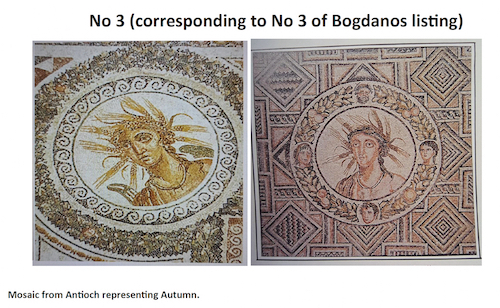
New York District Attorney Alvin Bragg announced the successful investigation and return of nine mosaic panels and other objects to Lebanon at a celebratory press conference with Lebanese diplomats on September 7, 2023. However, the mosaics’ repatriation soon turned into an embarrassing fiasco for the DA. The challenge to the DA’s claims of authenticity came from an unexpected source. Djamila Fellague[1], a respected French art historian, confirmed in a November 19 article in the Guardian by Dalya Alberge that at least eight of the nine mosaics returned by the DA’s office to Lebanon were not only fakes, but blatant copies of famous mosaics in museum collections or based on photographic images from well-known, excavated sites. Fellague told the Guardian that the fakes were relatively easy to detect because the models used were famous mosaics.
Dr. Fellague did not list all the fake mosaics but she illustrated a number of them in a brief article that she described as a work in progress:
- Mosaic of an Anguiped Giant, original in the Gigantomachy Mosaic, Villa de Casale, Sicily
- Lycurgus and Ambrosia, original in the House of Bacchus, Algeria
- Autumn mosaic, original is a detail of the Seasons Mosaic, Acholla, Bardo Museum, Tunis
- Summer Mosaic, border, original Ananeosis Mosaic, Antakya Archaeology Museum, Turkey – Summer Mosaic, center, detail of a season in the Apollo and Marsyas Mosaic, El Djem Museum
- Panther and deer mosaic, original mosaic from excavation of a church, Hauwarté
- Neptune and Amphrite, original a mosaic from Constantine in Algeria, now in the Louvre, Paris
Fellague’s findings were immediately confirmed by a former colleague of Bogdanos, antiquities hunter and forensic archaeologist Christos Tsirogiannis. Tsirogiannis recently broke with Bogdanos, complaining about the lack of credit for his work after years of supplying the Asst. DA with information on smuggled antiquities. Tsirogiannis weighed in immediately on Fellague’s identification of the original mosaics from which the seized mosaic were copied: “Even if you are not an expert, if you put the fake next to the authentic mosaic, you see how similar they are, but also how the quality is actually not that good.”
Additional Copies and their Sources

Georges Lotfi spoke recently with Cultural Property News in an interview from Lebanon. He provided CPN with eleven images from the total of twenty-three seized mosaics from Lebanon and Syria that he said were copies, together with images of the authentic originals from which they were copied or used as templates. (Lotfi’s images are published here just as they were sent, number-coordinated with a list he had of seized items from Bogdanos.)
Lotfi also says that although these fake mosaics were shipped out of Lebanon, that they were made in Syria by a forger who he was later able to contact through the seller of the mosaics, a man who called himself Abu Abdo. The forger told Lotfi that he would be glad to make fake mosaics from photographs of old ones, using them as models.
Lotfi claims that the real mosaics seized by Bogdanos came from Lebanon and were sold to him by licensed art dealers Farid Ziadeh and Muhammad al Haddad, both of whom held official licenses issued by the Lebanese Ministry of Culture at the time.
How had the DA’s experts slipped up so badly? Had the Assistant DA failed to even look into the authenticity of the mosaics or just been determined to make the charges stick – denying Lotfi’s protestations that the mosaics were fakes in order to claim another restitution “worth millions” and score another public relations hit for the Antiquities Trafficking Unit?
Bogdanos’ investigation of the seized items seems to have been either sloppy – which is puzzling, given his access to scholars and the enormous resources of a major prosecutorial organization – or negligent. Could he have been so sure of his immunity from criticism that he didn’t care whether the mosaics were real or not?

The affidavit states that the antiquities had been reviewed by experts. According to Mancene’s affidavit, the primary justification for their antiquity was that a judge had reviewed the evidence presented by the District Attorney’s office and determined that the mosaics were authentic. Mancene also wrote that the mosaics were inspected in person by Dr. Brian Rose of the University of Pennsylvania, who stated that some mosaics appeared to be completely intact while others showed evidence of modern restoration and additions. That statement in the affidavit simply skirts the issue. According to the warrant, a Ms. Hind Younes, an archaeologist with the Lebanese Ministry of Culture & Directorate General of Antiquities, had inspected Lotfi’s Tripoli villa and seen that he was “restoring ancient mosaics using authentic tesserae.” Again, this is hardly an affirmation of the authenticity of the objects in New York.
The charges under the warrant are based on the twenty-four allegedly looted antiquities seized on September 21, 2021.
The 36-page affidavit justifies seizures of antiquities in general as looted based on physical evidence that Mancene describes as consistent with looting (for example, having dirt, encrustation or broken and repaired elements). Such evidence is both circumstantial and true of many excavated objects. It is also true of fakes, which are dirtied and broken to make them look as if they have just come out of the ground.
The affidavit has more to say about Lotfi’s alleged past trafficking of looted artifacts and detailed knowledge of the antiquities trade than it does about the theft or smuggling of the antiquities that he is charged with possessing. The warrant also describes unrelated events and transactions involving ancient art in which looted objects are said to have passed through Lotfi’s hands. These unrelated events are used to show his continuing involvement with illicit antiquities, but they are not evidence with respect to the seized objects.[2]
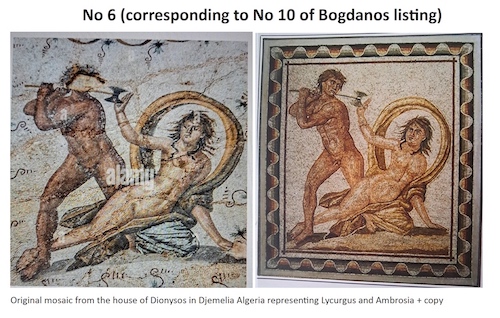
The date of the exportation of the mosaics raises other questions having to do with Lebanon’s enforcement of its export laws. The mosaics seized from Lotfi were exported from Lebanon in fall 1988, soon after Lebanon issued a tourist directive eliminating antiquities vendors’ licenses and restricting the export of all antiquities.[3] The DANY’s affidavit states repeatedly that Lotfi himself told Mancene that he had no government permits for export. However, the shipping document, a bill of lading, makes clear that the goods were at least processed by Lebanese authorities and transported by legitimate international carriers, raising questions about what Lotfi and the District Attorney each mean by a ‘permit.’ It is also uncertain whether or not Lebanon even had a system to provide permits in the first place.[4]
Charges of Personal Betrayal by a Longstanding Informant
Georges Lotfi is furious with Matthew Bogdanos and Robert Mancene. Lotfi is currently in Lebanon, where he is shielded from a NY arrest warrant – although an Interpol Red Notice, an international warrant against him, was made public in June of 2023.Georges and Claude Lotfi’s Christmas card for this year is unusual. It reads, “Merry Christmas and Happy New Year 2024,” but the picture is of a mosaic of Iphegenia and her brother Orestes, captioned “stolen by Bogdanos.”
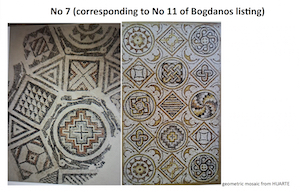
The relationship between Manhattan Assistant DA Matthew Bogdanos and the octogenarian Lebanese art collector and police informant was certainly complex, a convoluted plot worthy of the movies. Lotfi was known as a source for Bogdanos – he had tipped the cops off about what became their highest profile looted antiquities case, the illicit origin of the Metropolitan Museum’s gold Egyptian sarcophagus. Lotfi also told the DA that he had once owned a carved marble sculpture of a bull’s head, seized from the Metropolitan Museum in July 2017, where it was on loan. The bull’s head sculpture was the subject of another notorious case; it was eventually returned to Lebanon together with a marble torso seized from Lotfi’s apartment in 2017.[5]
After Asst. DA Bogdanos and Homeland Security Special Agent Robert Mancene seized the mosaics and sculpture from Lotfi’s warehouse spaces, Lotfi responded via a webpage set up in Paris. In a series of Open Letters posted on the webpage, Lotfi told his story, a complicated tale of alleged duplicity and lack of faith by Bogdanos and Mancene. Lotfi claimed he’d told them for years about how he bought antiquities from licensed dealers in Lebanon and exported his goods legally. Lotfi has repeatedly stated that that his removal of antiquities from Lebanon during the 1970s-80s was in order to “save them from destruction in Lebanon’s civil war” and from subsequent instability and terrorism in the country. Lotfi urged Bogdanos to acknowledge his contributions to stopping trade in looted antiquities on this Open Letter webpage, which included numerous photos and personal messages to and from Bogdanos.
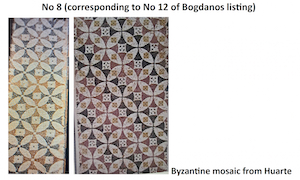
Lotfi’s lengthy collaboration with the DA appears to demonstrate his eagerness to stop looting by others today. In addition, nowhere in the subsequent records, the 2022 arrest warrant or in Lotfi’s accounts is there any evidence of a ‘deal’ between Lotfi and Bogdanos and Mancene to use Lotfi as an informant in exchange for not prosecuting him. Mancene’s insistence on characterizing the relationship between the DA’s Antiquities Trafficking Unit as a deliberate attempt by Lotfi to exploit their connection rings somewhat false in light of Lotfi’s clear sense of betrayal and his attempts to reach out and make contact with other staff he worked with there. The real story is more complicated than that.
Lotfi spoke to CPN of a close relationship that descended into personal insults after the seizure, when Bogdanos insisted Lofti must sign a document waiving all claims against the DA and the federal Department of Homeland Security for the seized antiquities. An email forwarded to CPN to Lofti from Bogdanos that was also published on Lotfi’s website stated: “Sign it and be a savior. Refuse to sign and be nothing more than a common thief.”
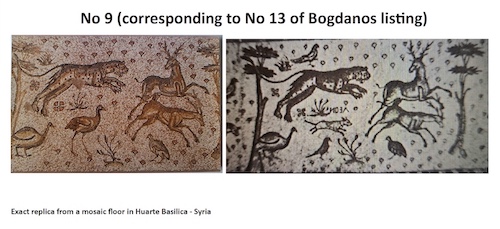
An outsider would be inclined to see this clash of cultures and ways of thinking about antiquities as impossible to resolve – to find the relationship irrevocably terminated in the statements in the arrest warrant and Mancene’s affidavit. However, while deeply saddened by what he sees as Bogdanos’ betrayal, Lotfi is also still seeking an explanation for Bogdanos’ attitude towards him and a way to find some common ground. He says he is concerned about Bogdanos’ state of mind. Lotfi points to the history of parental violence and the unfriendly characterizations of Bogdanos by his prosecutorial colleagues that were set forth in an article in the Atlantic by Ariel Sabar.[6] Lotfi is not shy about speculating on Bogdanos personality and behavior, commenting that he has traits “associated with megalomania and psychopathic behaviors.” Lotfi is also convinced that Bogdanos has some form of contact trauma from his frequent boxing. In July 2022, Lotfi wrote to Bogdanos’ boss, DA Alvin Bragg, stating:
“I am writing to you today to draw your attention on the incredible behavior of Colonel Bogdanos. As a doctor in pharmacology and my experience in medicine (I am almost 82 years) I can say that Mr. Bogdanos has a problem because of his boxing sport, creating a post-concussion syndrome.”
Conclusion
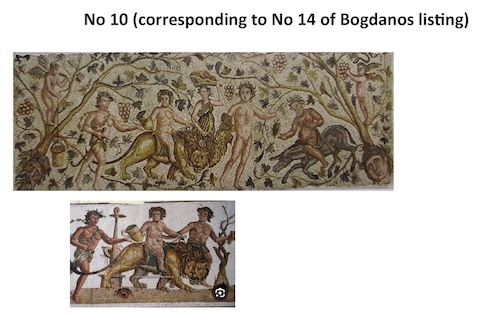
It doesn’t appear that Lotfi’s emphasis on the personal or the fact that he has been helpful to the District Attorney’s office in the past is likely to result in Bogdanos or Bragg seeking a peaceful resolution of the case against him.
If Lotfi’s statements give offense to Bogdanos and Mancene, they aren’t very different from Bogdanos assertion that Lotfi must sign away all rights to his property or be deemed “a thief,” or Mancene’s dismissive and disparaging statements about Lotfi’s motives and state of mind in the affidavit supporting the arrest warrant. The affidavit does not tell the whole story – that’s not its function under the law. The affidavit is an entirely subjective and one-sided statement – but it is based almost entirely upon Lotfi’s shared confidences with Bogdanos and Mancene and the Antiquities Trafficking Unit – not on police investigations.
The whole story can only be told in court, where both sides can present evidence and argue how the law should apply. Unfortunately, Bogdanos’ and Bragg’s process does not invite the kind of public hearing a court can offer. If convicted under New York law, Lotfi faces a mandatory minimum 1- to 3-year prison sentence. The 83-year-old could be sentenced to up to 25 years in state prison if he is convicted of the most serious felony charge of Possession of Stolen Property valued over $1,000,000. Given the cost of lawyers and court proceedings and the virtually infinite resources of a public prosecutor, few if any collectors or art dealers in this case or any other will ever be able to stand up to tell their side of the story in court.
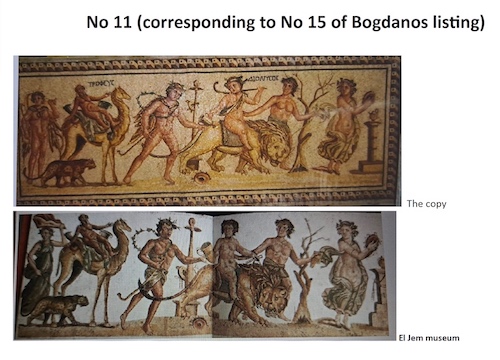
Whatever the reader’s conclusions about the mens rea of the accused or the goals of the prosecutor, it is important to bring the issues and the facts forward. In this case, the key fact is that New York County suffered entirely unnecessary costs and waste of public resources because Bogdanos’ Antiquities Trafficking Unit failed to properly investigate whether allegedly ‘irreplaceable’ looted antiquities were antiquities at all.
Additional Reading:
J’accuse! Georges Lotfi’s Dramatic Open Letter to Bogdanos’ Antiquities Trafficking Unit: 81 Year Old Art Dealer Responds to NY Warrant for Arrest: the Affidavit, Countercharges, and Legal Background, CPN, September 19, 2022.
Notes:
[1] Djamila Fellague is Lecturer in History of Art and Archaeology, Antiquity, University of Grenoble Alpes, Researcher at Luhcie (UGA), and associate researcher Arar and IRAA (Maison de l’Orient et de la Méditerranée).
[2] Some references are about objects that were photographed in Lotfi’s apartment and later discovered to have been looted, or are about looted objects said by other informants to have been sold to him, or reference looted objects associated with him in various ways whose whereabouts are presently unknown. Warrant, pages 12-16. Some of the concerned objects in the warrant do appear to be ancient.
[3] A brief 1988 decree from the Ministry of Tourism forbidding export of antiquities dramatically changed the rules that previously allowed export under a permit. The Tourist Decree was issued the same year that Lotfi’s mosaics were exported, apparently before his shipment left, but the actual date of publication in the official gazette on which it became effective is not known, nor when Lotfi’s container of mosaics cleared customs. Lotfi possesses bills of lading and other shipping papers, but Mancene’s warrant dismisses these as inadequate.
[4] While both the DANY affidavit’s assertions and Lotfi’s web-publications are self-serving, the laws of the period, dating back to 1933, shows the extent that Lebanon’s government permitted trading and export of antiquities. The Lebanese laws themselves raise questions regarding the DANY/HSI affidavit’s allegations that all art taken from Lebanon was ‘stolen.’
[5] The bull’s head sculpture was said to be worth $1 million in 2017; Lotfi had recognized it as a piece he’d sold years before for $3,500.
[6] Ariel Sabar, The Tomb Raiders of the Upper East Side: Inside the Manhattan DA’s Antiquities Trafficking Unit, The Atlantic, November 23, 2021.

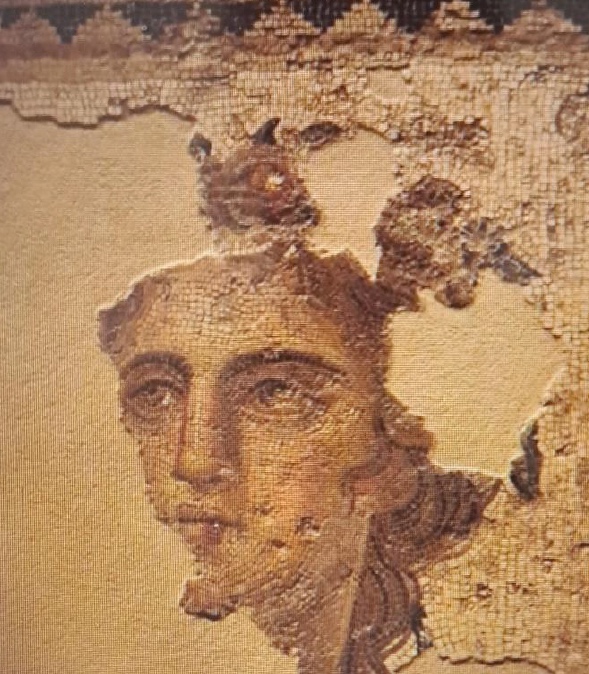 Authentic mosaic in the Beirut Museum, a source for copies made in Lebanon or Syria. Image courtesy Georges Lotfi.
Authentic mosaic in the Beirut Museum, a source for copies made in Lebanon or Syria. Image courtesy Georges Lotfi. 

